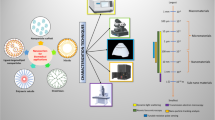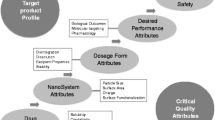Abstract
The Food and Drug Administration (FDA) and pharmaceutical industry have used standards to assess material biocompatibility, immunotoxicity, purity, and sterility (as well as many other properties) for several decades. Nanoparticle developers and manufacturers leverage well-established methods as much as possible. However, the unique properties of nanomaterials often interfere with standardized protocols, giving false-positive or false-negative results. This chapter provides details of some of the problems which can arise during the characterization of nanoparticle samples. Additionally, we discuss ways to identify, avoid, and resolve such interference, with emphasis on the use of inhibition and enhancement controls.
Access this chapter
Tax calculation will be finalised at checkout
Purchases are for personal use only
Similar content being viewed by others
References
For the remainder of the chapter we confine the discussion to the IND process for drugs regulated through the FDA’s Center for Drug Evaluation and Research (CDER). A similar process is required in the Investigational Device Exemption (IDE) filing for a device regulated through the FDA’s Center for Devices and Radiological Health (CDRH).
Kobayashi H, Kawamoto S, Jo SK, Bryant HL, Jr, Brechbiel MW, Star RA. Macromolecular MRI contrast agents with small dendrimers: pharmacokinetic differences between sizes and cores. Bioconjugate Chemistry 2003; 14: 388–394.
Oberdorster G, Oberdorster E, Oberdorster J. Nanotoxicology: an emerging discipline evolving from studies of ultrafine particles. Environmental Health Perspectives 2005; 113: 823–839.
Furumoto K, Nagayama S, Ogawara K, Takakura Y, Hashida M, Higaki K, Kimura T. Hepatic uptake of negatively charged particles in rats: possible involvement of serum proteins in recognition by scavenger receptor. Journal of Controlled Release 2004; 97: 133–141.
Oberdorster G. Toxicology of ultrafine particles: in vivo studies. Philosophical Transactions of the Royal Society of London Series A, Mathematical Physical and Engineering Sciences 2000; 358: 2719–2739.
Ogawara K, Yoshida M, Higaki K, Kimura T, Shiraishi K, Nishikawa M, Takakura Y, Hashida M. Hepatic uptake of polystyrene microspheres in rats: effect of particle size on intrahepatic distribution. Journal of Controlled Release 1999; 59: 15–22.
Ogawara K, Yoshida M, Kubo J, Nishikawa M, Takakura Y, Hashida M, Higaki K, Kimura T. Mechanisms of hepatic disposition of polystyrene microspheres in rats: effects of serum depend on the sizes of microspheres. Journal of Controlled Release 1999; 61: 241–250.
Fenart L, Casanova A, Dehouck B, Duhem C, Slupek S, Cecchelli R, Betbeder D. Evaluation of effect of charge and lipid coating on ability of 60-nm nanoparticles to cross an in vitro model of the blood-brain barrier. Journal of Pharmacology and Experimental Therapeutics 1999; 291: 1017–1022.
Rajananthanan P, Attard GS, Sheikh NA, Morrow WJ. Novel aggregate structure adjuvants modulate lymphocyte proliferation and Th1 and Th2 cytokine profiles in ovalbumin immunized mice. Vaccine 1999; 18: 140–152.
ASTM International Standard Practice F748-98. “Selecting generic biological test methods for materials and devices.”
Acknowledgments
This project has been funded in whole or in part with federal funds from the National Cancer Institute, National Institutes of Health, under contract N01-CO-12400. The content of this publication does not necessarily reflect the views or policies of the Department of Health and Human Services, nor does mention of trade names, commercial products, or organizations imply endorsement by the US Government.
Author information
Authors and Affiliations
Editor information
Editors and Affiliations
Rights and permissions
Copyright information
© 2011 Springer Science+Business Media, LLC
About this protocol
Cite this protocol
McNeil, S.E. (2011). Challenges for Nanoparticle Characterization. In: McNeil, S. (eds) Characterization of Nanoparticles Intended for Drug Delivery. Methods in Molecular Biology, vol 697. Humana Press. https://doi.org/10.1007/978-1-60327-198-1_2
Download citation
DOI: https://doi.org/10.1007/978-1-60327-198-1_2
Published:
Publisher Name: Humana Press
Print ISBN: 978-1-60327-197-4
Online ISBN: 978-1-60327-198-1
eBook Packages: Springer Protocols




